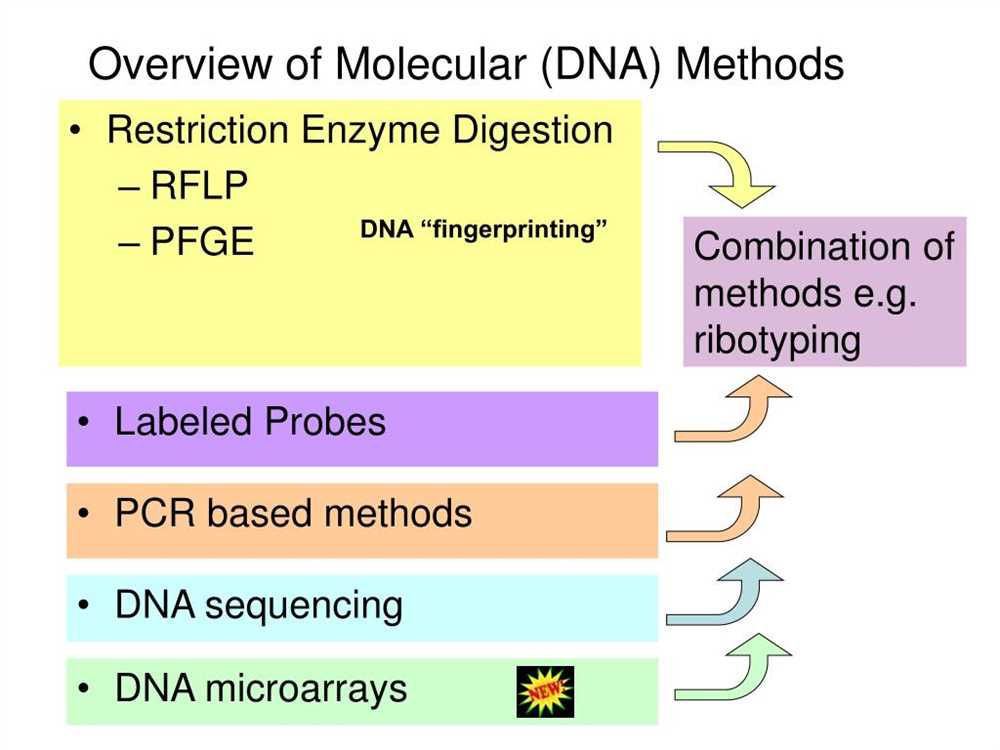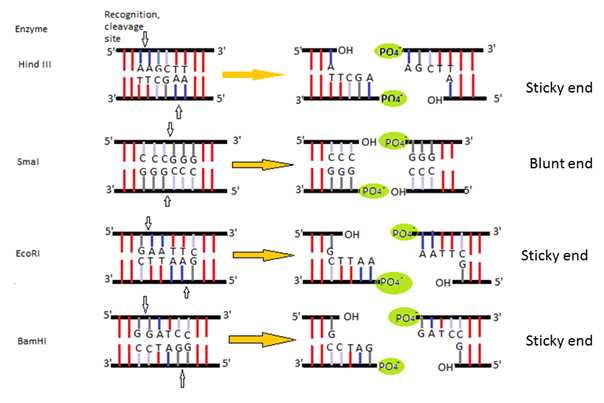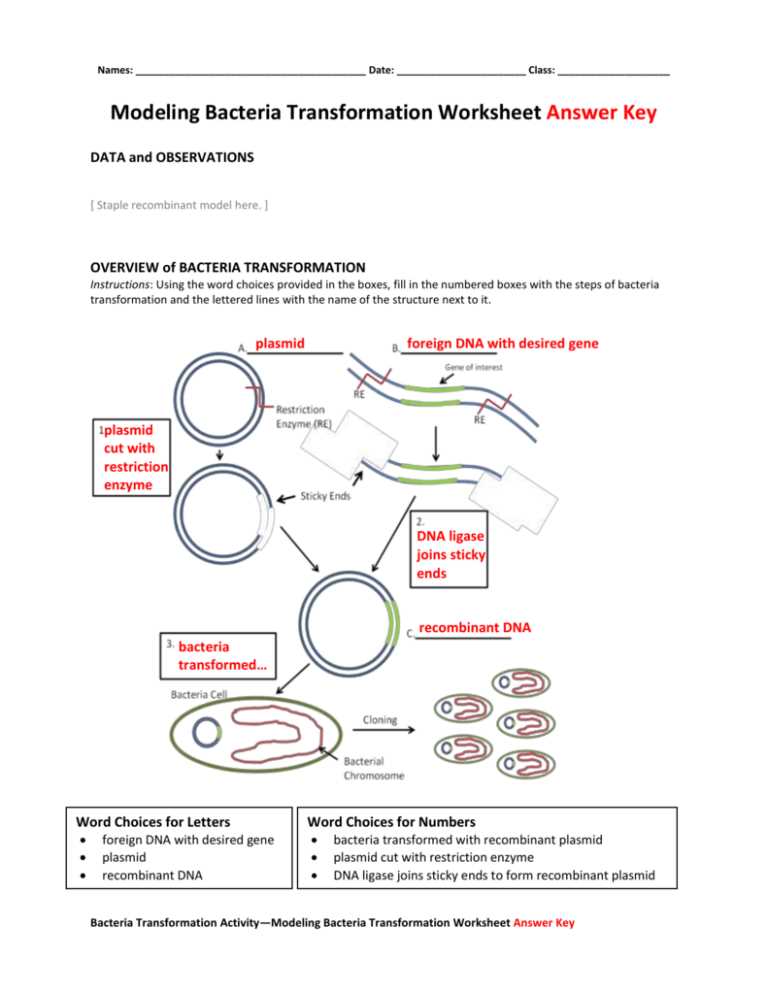
Restriction enzyme analysis is an important technique in molecular biology that allows researchers to cut DNA into specific fragments. This technique uses restriction enzymes, also known as restriction endonucleases, which are enzymes that can recognize specific DNA sequences and cut the DNA at those sites.
In this article, we will provide the answer key to some common questions related to restriction enzyme analysis. These questions cover topics such as the function of restriction enzymes, the steps involved in restriction enzyme analysis, and the applications of this technique in research.
One commonly asked question is, “What is the function of restriction enzymes in DNA analysis?” The function of restriction enzymes is to cut DNA at specific recognition sites. These recognition sites are usually palindromic sequences, meaning that they read the same forward and backward. When a restriction enzyme recognizes its specific sequence, it binds to the DNA and cuts it, resulting in the formation of fragments.
Another question often asked is, “What are the steps involved in restriction enzyme analysis?” The steps of restriction enzyme analysis include DNA extraction, selection of appropriate restriction enzymes, digestion of DNA with the restriction enzymes, electrophoresis to separate the fragmented DNA, and visualization of the DNA fragments using techniques like staining or autoradiography.
Finally, researchers often inquire about the applications of restriction enzyme analysis. This technique is widely used in various areas of research, including genetics, genomics, and molecular biology. It can be used to study DNA sequences, identify genetic variations, create recombinant DNA molecules, analyze gene expression, and much more.
In conclusion, restriction enzyme analysis is a powerful tool in molecular biology that allows researchers to cut DNA into specific fragments. Understanding the function of restriction enzymes, the steps involved in this technique, and its applications can help scientists make valuable discoveries and advancements in various fields.
What is Restriction Enzyme Analysis?
Restriction enzyme analysis is a technique used in molecular biology to study the DNA sequence of an organism. Restriction enzymes are naturally occurring proteins that can recognize specific DNA sequences and cut the DNA at those sites. By using different restriction enzymes and analyzing the pattern of DNA fragments produced, scientists can determine the presence or absence of specific DNA sequences and gain insights into the genetic makeup of an organism.
Restriction enzyme analysis is often used in DNA fingerprinting, genetic mapping, and studies of gene expression. In DNA fingerprinting, DNA samples from different individuals are digested with restriction enzymes, and the resulting DNA fragments are separated using gel electrophoresis. The pattern of fragments can then be compared to determine the relatedness or identity of the individuals. In genetic mapping, restriction enzyme analysis is used to determine the order and distance between specific DNA markers on a chromosome. And in studies of gene expression, restriction enzymes can be used to analyze the presence or absence of specific genes in different tissues or under different experimental conditions.
Steps of Restriction Enzyme Analysis:

- Isolation and purification of DNA: DNA is extracted from the organism or tissue of interest.
- Digestion with restriction enzymes: The isolated DNA is then digested with specific restriction enzymes that recognize and cut at specific DNA sequences.
- Separation of DNA fragments: The digested DNA is separated using gel electrophoresis, a technique that separates DNA fragments based on their size and charge.
- Visualization and analysis of DNA fragments: The separated DNA fragments are visualized using techniques such as staining or radioactive labeling, and the resulting pattern is analyzed.
Overall, restriction enzyme analysis is a powerful tool in molecular biology that allows scientists to study DNA sequences and gain insights into the genetic makeup and function of organisms.
The Definition and Importance of Restriction Enzymes

Restriction enzymes, also known as restriction endonucleases, are enzymes that are found naturally in bacteria. These enzymes have the ability to recognize specific DNA sequences and cut the DNA at those sites. They are essential tools in molecular biology and genetic engineering, playing a crucial role in many techniques and experiments.
The way restriction enzymes work is by binding to a specific DNA sequence known as a recognition site. This site usually consists of 4-8 base pairs, and each restriction enzyme recognizes a different sequence. Once the enzyme binds to the recognition site, it cuts the DNA at specific points, creating two fragments with sticky ends or blunt ends.
The importance of restriction enzymes lies in their ability to cut DNA at specific sites. This allows scientists to manipulate DNA in a controlled manner. By cutting DNA at specific points and then joining different fragments of DNA together, researchers can create new combinations of DNA sequences. This is particularly useful in genetic engineering, as it allows the creation of recombinant DNA molecules, which can be used to produce proteins or study gene function.
In addition, restriction enzymes are used in techniques such as restriction fragment length polymorphism (RFLP) analysis, DNA fingerprinting, and gene cloning. These techniques rely on the ability of restriction enzymes to cut DNA at specific sites and produce DNA fragments of different sizes, which can be analyzed and compared.
- Overall, restriction enzymes are fundamental tools in molecular biology and genetic engineering.
- They allow scientists to manipulate DNA and create new combinations of DNA sequences.
- Restriction enzymes are used in various techniques, such as RFLP analysis and gene cloning.
- Their ability to cut DNA at specific sites makes them essential in studying gene function and producing recombinant DNA molecules.
Understanding Restriction Enzyme Analysis
Restriction enzyme analysis is a commonly used technique in molecular biology that allows scientists to study DNA fragments and analyze their structure. It involves the use of restriction enzymes, which are proteins that can recognize and cut DNA at specific sequences called restriction sites. These restriction enzymes are derived from bacteria and have been widely studied and characterized.
One key aspect of restriction enzyme analysis is DNA digestion. During this process, DNA is treated with a restriction enzyme, which cuts the DNA at specific sites. The resulting fragments can then be separated using techniques such as gel electrophoresis, which separates DNA fragments based on their size. This allows scientists to visualize the fragments and analyze their patterns.
The pattern of DNA fragments obtained after digestion with restriction enzymes is unique to each DNA sample. This is because the DNA sequence and the location of restriction sites can vary between individuals or species. By comparing the patterns obtained from different samples, scientists can determine the similarities and differences in their DNA sequences.
Restriction enzyme analysis has various applications in molecular biology. It can be used to identify specific DNA sequences, such as those associated with genetic disorders or gene mutations. It can also be used to study DNA structure and function, as well as to analyze DNA samples for forensic or diagnostic purposes. The technique is highly versatile and has become an essential tool in molecular biology research.
Key Points:
- Restriction enzyme analysis is a technique that uses restriction enzymes to cut DNA at specific sites.
- The resulting DNA fragments can be separated using techniques such as gel electrophoresis.
- The pattern of DNA fragments obtained after digestion is unique to each DNA sample.
- Restriction enzyme analysis has various applications in molecular biology research.
How does Restriction Enzyme Analysis Work?
Restriction enzyme analysis is a technique used in molecular biology to analyze and manipulate DNA. It involves the use of restriction enzymes, which are enzymes that can cut DNA at specific recognition sites. These enzymes recognize specific DNA sequences and create breaks in the DNA molecule, resulting in fragments of different sizes.
First, a sample of DNA is obtained and purified. The DNA is then treated with a restriction enzyme, which cleaves the DNA at specific recognition sites. Each restriction enzyme recognizes a different DNA sequence, resulting in different patterns of DNA fragments after digestion. These fragments can be separated using techniques such as gel electrophoresis.
The DNA fragments are loaded onto a gel, and an electric current is applied. The fragments migrate through the gel based on their size, with smaller fragments moving faster than larger fragments. This separation allows the different fragments to be visualized as distinct bands on the gel.
To analyze the DNA fragments, they can be stained with a dye that binds to DNA and fluoresces under ultraviolet light. The pattern of bands on the gel can be compared to known DNA standards or to other samples to determine the presence or absence of specific DNA sequences. This can be useful in various applications, such as genetic testing, paternity testing, and forensics.
The Process of Restriction Enzyme Analysis
Restriction enzyme analysis is a technique used in molecular biology to cut DNA molecules into specific fragments. This process is instrumental in various applications, including DNA sequencing, genotyping, and genetic engineering. Restriction enzymes, also known as restriction endonucleases, are enzymes that recognize and cleave DNA at specific sequences, known as recognition sites. These recognition sites are typically short sequences of 4-8 base pairs.
The first step in restriction enzyme analysis is the selection of the appropriate restriction enzyme(s) for the experiment. This involves identifying the target DNA sequence and determining which restriction enzyme(s) recognize and cut at or near that sequence. The selection is based on the specific recognition site of the enzyme and the desired fragment size for analysis. The availability of restriction enzymes with different recognition sites offers researchers a wide range of options.
Once the appropriate restriction enzyme(s) are selected, the next step is the preparation of the DNA sample for analysis. This involves isolating the DNA from the source material and purifying it to remove any contaminants. After purification, the DNA is typically quantified, and the concentration adjusted to ensure optimal digestion by the restriction enzyme(s).
After the DNA sample is prepared, it is incubated with the selected restriction enzyme(s) at the appropriate temperature and reaction conditions. The restriction enzyme recognizes its specific recognition site(s) on the DNA molecule and cleaves the DNA at these sites. The resulting DNA fragments are typically separated using gel electrophoresis, a technique that separates DNA fragments based on their size. The separated fragments can then be visualized using staining techniques, such as ethidium bromide, and analyzed using various methods, including DNA sequencing or agarose gel documentation systems.
Overall, restriction enzyme analysis is a powerful tool in molecular biology that allows researchers to manipulate, analyze, and study DNA fragments with precision. By selecting the appropriate restriction enzyme(s) and optimizing the experimental conditions, researchers can obtain valuable information about DNA sequences and their functions.
Steps involved in Restriction Enzyme Analysis

Restriction enzyme analysis is a technique used to study DNA fragments and determine their structure and composition. This method utilizes restriction enzymes, which are enzymes that can recognize specific DNA sequences and cut the DNA at those locations. The following steps are involved in restriction enzyme analysis:
- Isolation of DNA: The first step in restriction enzyme analysis is to isolate the DNA from the sample of interest. This can be done using various techniques depending on the source of the DNA, such as cell lysis and DNA extraction.
- Digestion with restriction enzymes: Once the DNA is isolated, it is treated with specific restriction enzymes that recognize and cut DNA at specific sequences. The choice of restriction enzymes depends on the desired analysis and the presence of the specific recognition sites in the DNA.
- Electrophoresis: The digested DNA fragments are then separated using gel electrophoresis. This technique uses an electric field to move the DNA fragments through a gel matrix based on their size. The smaller fragments migrate faster than the larger ones.
- Visualization: After electrophoresis, the DNA fragments are visualized using various staining techniques. One common method is to use ethidium bromide, which binds to DNA and fluoresces under ultraviolet light.
- Analysis: The final step involves analyzing the DNA fragment patterns obtained from the electrophoresis. The pattern of fragments can be compared to known standards or used to determine the sequence or structure of the original DNA.
Restriction enzyme analysis is widely used in molecular biology research, genetic engineering, and forensic science. It allows scientists to study DNA in detail and uncover valuable information about its composition and function.
Applications of Restriction Enzyme Analysis
Restriction enzyme analysis, also known as restriction fragment length polymorphism (RFLP) analysis, is a powerful tool used in molecular biology research and applications. It allows researchers to study and analyze DNA sequences by cutting them into fragments using specific restriction enzymes. These fragments can then be separated and analyzed to determine various genetic characteristics and variations.
1. Genetic Mapping: One of the main applications of restriction enzyme analysis is genetic mapping. By using restriction enzymes to cut DNA into fragments, researchers can create restriction maps that show the order and distance between different restriction sites on a DNA molecule. This information is crucial for understanding the structure and organization of genes within a genome.
2. Disease Diagnosis: Restriction enzyme analysis can also be used for disease diagnosis. Many genetic diseases are caused by specific mutations or variations in DNA sequences. By analyzing these sequences using restriction enzymes, researchers can identify the presence of mutations associated with certain diseases. This information can be used for genetic screening and early diagnosis of genetic disorders.
3. Forensic Analysis: Restriction enzyme analysis is widely used in forensic science for DNA profiling and identification. By comparing the pattern of restriction fragments obtained from a crime scene sample with those from a suspect or a DNA database, researchers can determine the likelihood of a match, providing valuable evidence in criminal investigations.
4. Evolutionary Studies: Restriction enzyme analysis has also been used in evolutionary studies to analyze genetic variations among different populations and species. By comparing restriction fragment patterns, researchers can infer genetic relatedness and determine the evolutionary relationships between different organisms.
In conclusion, restriction enzyme analysis is a versatile technique with a wide range of applications in various fields of research and industry. It has revolutionized the study of genetics, allowing researchers to analyze DNA sequences and their variations, and providing valuable insights into genetic diseases, evolutionary relationships, and forensic identification.